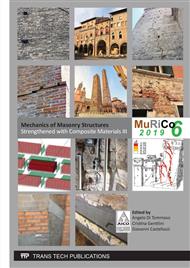[1]
D. G. Aggelis, A. C. Mpalaskas, T. E Matikas, Investigation of different fracture modes in cement-based materials by acoustic emission, Cement Concrete Res., 48 (2013) 1–8.
DOI: 10.1016/j.cemconres.2013.02.002
Google Scholar
[2]
K. Aki, A probabilistic synthesis of precursory phenomena, in: Earthquake Prediction, edited by: Simpson, D. W. and Richards, P. G., American Geophysical Union, Washington, D.C., USA, (1981) 566–574.
DOI: 10.1029/me004p0566
Google Scholar
[3]
P. Bak, C. Tang, Earthquakes as a self-organized critical phenomenon, J. Geophys. Res., 94, (1989) 15635–15637.
DOI: 10.1029/jb094ib11p15635
Google Scholar
[4]
M. Ohtsu, T.,Okamoto, S. Yuyama, Moment tensor analysis of acoustic emission for cracking mechanisms in concrete, ACI Struct. J., 95 81998) 87–95.
DOI: 10.14359/529
Google Scholar
[5]
P. Bak, K. Christensen, L. Danon, T. Scanlon, Unified scaling law for earthquakes, Phys. Rev. Lett., 88, 178501, https://doi.org/10.1103/PhysRevLett.88.178501, (2002).
DOI: 10.1103/physrevlett.90.109901
Google Scholar
[6]
A. Carpinteri, G. Lacidogna, Structural monitoring and integrity assessment of medieval towers, J. of Struct. Eng.(ASCE), 132 (2006) 1681-1690.
DOI: 10.1061/(asce)0733-9445(2006)132:11(1681)
Google Scholar
[7]
A. Carpinteri, G. Lacidogna (2007) Damage evaluation of three masonry towers by acoustic emission. Eng. Struc., 29 (2007) 1569-1579.
DOI: 10.1016/j.engstruct.2006.08.008
Google Scholar
[8]
A. Carpinteri, G. Lacidogna, (2008), Acoustic Emission and Critical Phenomena: From Structural Mechanics to Geophysics, CRC Press, Boca Raton.
DOI: 10.1201/9780203892220.ch13
Google Scholar
[9]
A. Anzani, L. Binda, L., A. Carpinteri, G. Lacidogna, A. Manuello, Evaluation of the repair on multiple leaf stone masonry by acoustic emission. Mat. and Struct. (RILEM), 41 (2008) 1169-1189.
DOI: 10.1617/s11527-007-9316-z
Google Scholar
[10]
A. Carpinteri, G. Lacidogna, G., Manuello, A,, Niccolini, G. (2016) A study on the structural stability of the Asinelli Tower in Bologna, Struct. Cont. and Health Monit., 23: 659-667.
DOI: 10.1002/stc.1804
Google Scholar
[11]
C. A. Costa de Beauregard, Familles historiques de Savoie. Les Seigneurs de Compey, Puthod, Chambéry 1884.
Google Scholar
[12]
G. Gentile, «Io maestro Meo di Francescho Fiorentino...». Documenti per il cantiere del Duomo di Torino, in Romano, Giovanni, Domenico della Rovere e il Duomo nuovo di Torino: Rinascimento a Roma e in Piemonte, Cassa di risparmio di Torino, Torino 1990, 107-200.
DOI: 10.2307/j.ctv2sbm7v5.11
Google Scholar
[13]
G. Niccolini, A. Carpinteri A. Manuello, E. Marchis (2017) Signal frequency distribution and natural-time analyses from acoustic emission monitoring of an arched structure in the Castle of Racconigi. Nat. Haz. and Earth Syst. Sci., 17 (2017) 1025-1032.
DOI: 10.5194/nhess-17-1025-2017
Google Scholar
[14]
D. Masera, P. Bocca, A. Grazzini Frequency Analysis of Acoustic Emission Signal to Monitor Damage Evolution in Masonry Structures. J. Phys.: Conf. Ser. 305 (2011) 1-10.
DOI: 10.1088/1742-6596/305/1/012134
Google Scholar
[15]
F. Omori, On aftershocks, Rep. Imp. Earthquake Invest. Comm., 2 (1894) 103–109.
Google Scholar
[16]
C. F. Richter, Elementary Seismology, W. H. Freeman and Company, San Francisco, USA and London, UK, (1958).
Google Scholar
[17]
A. Carpinteri, G. Lacidogna, G. Niccolini, S. Puzzi, Critical defect size distributions in concrete structures detected by the acoustic emission technique. Meccanica 43 (2008) 349–363.
DOI: 10.1007/s11012-007-9101-7
Google Scholar


